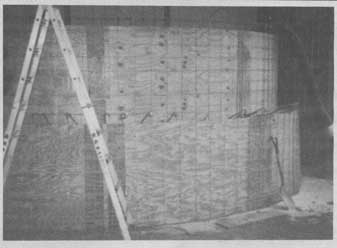
"I have used this temporary grain bin for five years. It's made out of materials that are easy to work with and that have other uses once the need for the bin is gone," says Richard Riessen, Walcott, Iowa.
"Materials include 4 by 8-ft. sheets of plywood, 1/2-in. wide plywood strips, wire cattle panels, carriage bolts, staples, and 1/4-in. cable clamps. The plywood panels are bolted together in a circle with the wood strips overlapping the ends. A ring of wire cattle panels runs around the outside to provide reinforcing. The cattle panels are tightened on the wood ring with a small come-a-long, similar to tightening fence wire, and then stapled to the wooden inner ring.
"To raise up a second 'wedding cake' layer of panels inside the rust ring (you should build the inner ring first, then the outer ring), I use common rubber tarp straps 15 to 20 in long. Raising the inner ring is a gradual process. First I hook the straps to the top edge of the outer ring and as far down on the inner ring as possible, hooking to the wire cattle panels. Then I keep going around the rings, raising the inner ring gradually as I go by moving the tarp straps farther and farther down the inner ring. When I reach the bottom of the inner ring, then I can start moving the hooks down the outside of the outer ring, if necessary.
"The bin shown in the photo uses 19 sheets of plywood and holds over 2,000 bu. of soybeans. I once built another bin that used 25 sheets of plywood and held about 4,500 bu. of corn. When I removed the corn, I used the livestock panels elsewhere and was able to store the stack of plywood sheets in a small area until needed again.
"I fill bins by auger and empty them with a grain vac. Care must be used when filling and emptying the bin, because its only strength is its circular shape. If grain pressure becomes too uneven, walls may fold or bend. I've been careful and never had a problem."
